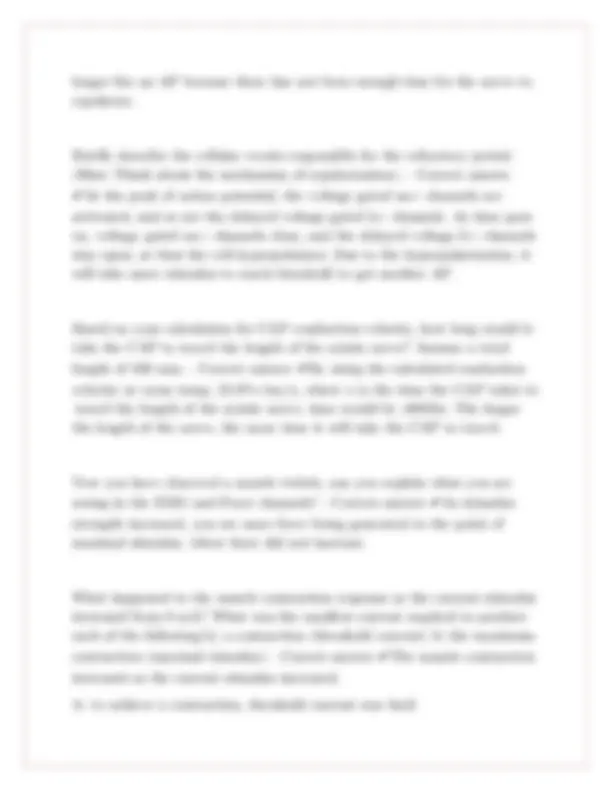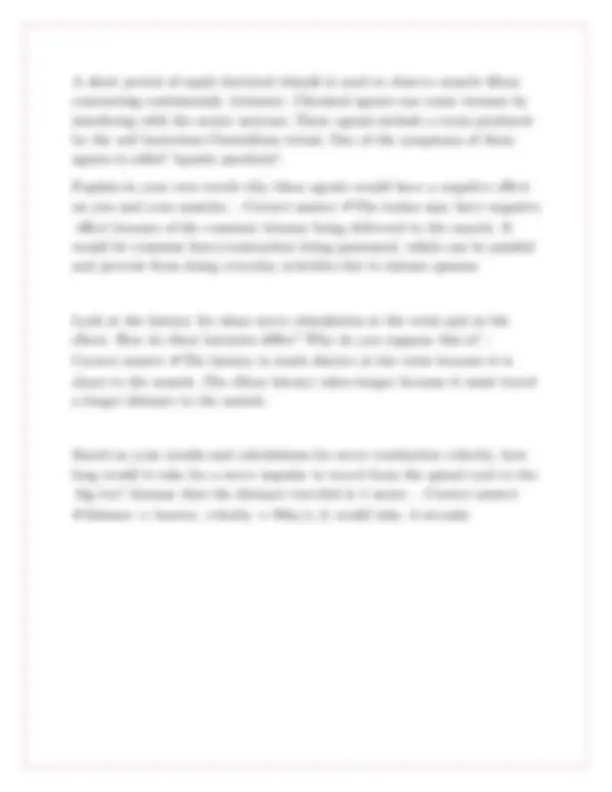





Study with the several resources on Docsity

Earn points by helping other students or get them with a premium plan


Prepare for your exams
Study with the several resources on Docsity

Earn points to download
Earn points by helping other students or get them with a premium plan
Community
Ask the community for help and clear up your study doubts
Discover the best universities in your country according to Docsity users
Free resources
Download our free guides on studying techniques, anxiety management strategies, and thesis advice from Docsity tutors
BIO 235 Lab Midterm Exam with precise detailed answers
Typology: Exams
1 / 5

This page cannot be seen from the preview
Don't miss anything!




The |! Isolated |! Stimulator |! passes |! a |! pulse |! of |! current |! through |! the |! volunteer's |! skin |! (for |! example, |! to |! make |! a |! muscle |! twitch). |! A |! green |! light |! indicates |! that |! the |! stimulator |! is |! delivering |! a |! pulse. |! What |! would |! it |! mean |! if |! the |! OOC |! light |! flashes |! yellow? |! - |! Correct |! answer |! ✔The |! current |! is |! not |! flowing |! properly. The |! switch |! turns |! the |! Isolated |! Stimulator |! on |! and |! off. |! Can |! you |! connect |! stimulating |! electrodes |! to |! yourself? |! - |! Correct |! answer |! ✔yes Which |! of |! the |! following |! electrical |! signals |! can |! be |! recorded |! with |! the |! Bip |! Amp |! and |! which |! cannot? |! - |! Correct |! answer |! ✔ECG, |! EEG, |! EMG |! can |! all |! be |! used What |! signal |! does |! the |! pulse |! transducer |! "transduce" |! into |! an |! electrical |! signal? |! - |! Correct |! answer |! ✔The |! changes |! in |! pressure |! from |! pulsatile |! blood |! flow |! in |! the |! arteries. Why |! would |! there |! be |! a |! lag |! between |! the |! raw |! data |! signal |! and |! the |! channel |! calculation |! signal |! that |! you |! see |! on |! screen? |! - |! Correct |! answer |! ✔Time |! to |! calculate, |! need |! to |! collect |! pulses |! to |! make |! the |! calculation Based |! on |! what |! you |! have |! seen |! today, |! why |! do |! you |! think |! it |! would |! be |! advisable |! to |! record |! the |! heart |! rate |! for |! 60 |! seconds |! rather |! than |! for |! a |! shorter |!
duration |! (for |! example, |! 15 |! or |! 30 |! seconds)? |! - |! Correct |! answer |! ✔A |! shorter |! time |! frame |! leaves |! more |! room |! for |! error, |! breathing |! can |! change |! you |! heart |! rate A |! shorter |! time |! frame |! less |! more |! more |! for |! error, |! breathing |! can |! change |! you |! heart |! rate |! - |! Correct |! answer |! ✔A |! CAP |! is |! the |! average |! of |! all |! the |! action |! potentials. Action |! potentials |! are |! said |! to |! be |! "all |! or |! none" |! responses. |! Why |! does |! the |! frog |! sciatic |! nerve |! give |! a |! graded |! response? |! - |! Correct |! answer |! ✔There |! is |! a |! graded |! response |! because |! there |! are |! different |! sized |! axons |! responding |! at |! different |! voltages. What |! was |! the |! smallest |! voltage |! required |! to |! produce |! the |! maximum |! (largest) |! CAP? |! What |! proportion |! of |! the |! nerve |! fibers |! were |! excited |! to |! produce |! this |! maximal |! response? |! - |! Correct |! answer |! ✔90mV. |! Most |! of |! the |! nerves |! should |! have |! been |! excited |! at |! the |! maximum |! CAP. In |! this |! activity, |! you |! examined |! the |! effect |! of |! increasing |! stimulus |! intensity |! on |! the |! nerve. |! What's |! another |! stimulus |! parameter |! that |! might |! also |! affect |! the |! nerve's |! tendency |! to |! generate |! a |! CAP? |! - |! Correct |! answer |! ✔Temperature |! may |! effect |! nerve's |! tendency |! as |! well Explain |! the |! difference |! between |! the |! relative |! and |! absolute |! refractory |! periods. |! - |! Correct |! answer |! ✔The |! relative |! refractory |! period |! is |! the |! interpulse |! interval |! at |! which |! there |! was |! the |! first |! decrease |! in |! the |! magnitude |! of |! the |! 2nd |! CAP, |! there |! is |! still |! ability |! to |! fire |! an |! AP |! if |! given |! enough |! stimulus |! to |! reach |! threshold |! again. |! Absolute |! refractory |! is |! the |! time |! at |! which |! the |! nerve |! can |! no |!
B- |! to |! achieve |! max |! contraction, |! the |! maximal |! stimulus |! was |! 14mA When |! the |! current |! reached |! the |! following |! stages, |! what |! proportion |! of |! fibers |! in |! the |! muscle |! were |! contracting?a) |! at |! thresholdb) |! at |! the |! maximal |! stimulusc) |! above |! the |! maximal |! stimulus |! - |! Correct |! answer |! ✔At |! threshold, |! the |! least |! amount |! of |! fibers |! were |! contracting- |! because |! of |! the |! smaller |! stimulus |! being |! delivered At |! maximal |! stimulus, |! the |! most |! amount |! of |! fibers |! were |! contracting |! to |! generate |! a |! larger |! force |! in |! response |! to |! the |! large |! stimulus Why |! does |! varying |! the |! stimulus |! strength |! affect |! the |! twitch |! force? |! - |! Correct |! answer |! ✔Varying |! stimulus |! strength |! affects |! twitch |! force |! by |! recruiting |! the |! different |! sized |! motor |! units. What |! is |! the |! difference |! between |! incomplete |! tetanus |! and |! complete |! tetanus? |! - |! Correct |! answer |! ✔incomplete |! tetanus |! has |! a |! relaxation |! period |! during |! contractions |! and |! Complete |! tetanus |! has |! no |! relaxation |! period |! during |! contractions The |! stimulus |! interval |! has |! a |! profound |! effect |! on |! the |! contraction |! force |! of |! the |! muscle. |! In |! your |! own |! words |! explain |! what |! happened |! when |! the |! muscle |! was |! stimulated |! in |! rapid |! succession. |! At |! which |! interval |! did |! the |! volunteer's |! muscle |! twitches |! begin |! to |! merge |! together |! (summate)? |! - |! Correct |! answer |! ✔When |! muscle |! is |! stimulated |! in |! rapid |! succession, |! more |! residual |! calcium |! remains |! in |! the |! muscle, |! therefore |! allowing |! for |! more |! force |! to |! be |! generated |! when |! the |! muscle |! twitches |! summate. |! They |! began |! to |! merge |! together |! at |! 100ms, |! but |! at |! 50ms |! they |! completely |! merged.
A |! short |! period |! of |! rapid |! electrical |! stimuli |! is |! used |! to |! observe |! muscle |! fibers |! contracting |! continuously |! (tetanus). |! Chemical |! agents |! can |! cause |! tetanus |! by |! interfering |! with |! the |! motor |! neurons. |! These |! agents |! include |! a |! toxin |! produced |! by |! the |! soil |! bacterium |! Clostridium |! tetani. |! One |! of |! the |! symptoms |! of |! these |! agents |! is |! called |! "spastic |! paralysis". Explain |! in |! your |! own |! words |! why |! these |! agents |! would |! have |! a |! negative |! effect |! on |! you |! and |! your |! muscles. |! - |! Correct |! answer |! ✔The |! toxins |! may |! have |! negative |! effect |! because |! of |! the |! constant |! tetanus |! being |! delivered |! to |! the |! muscle. |! It |! would |! be |! constant |! force/contraction |! being |! generated, |! which |! can |! be |! painful |! and |! prevent |! from |! doing |! everyday |! activities |! due |! to |! intense |! spasms. Look |! at |! the |! latency |! for |! ulnar |! nerve |! stimulation |! at |! the |! wrist |! and |! at |! the |! elbow. |! How |! do |! these |! latencies |! differ? |! Why |! do |! you |! suppose |! this |! is? |! - |! Correct |! answer |! ✔The |! latency |! is |! much |! shorter |! at |! the |! wrist |! because |! it |! is |! closer |! to |! the |! muscle. |! The |! elbow |! latency |! takes |! longer |! because |! it |! must |! travel |! a |! longer |! distance |! to |! the |! muscle. Based |! on |! your |! results |! and |! calculations |! for |! nerve |! conduction |! velocity, |! how |! long |! would |! it |! take |! for |! a |! nerve |! impulse |! to |! travel |! from |! the |! spinal |! cord |! to |! the |! big |! toe? |! Assume |! that |! the |! distance |! traveled |! is |! 1 |! meter. |! - |! Correct |! answer |! ✔distance |! = |! 1meter, |! velocity |! = |! 80m/s, |! it |! would |! take |! .8 |! seconds